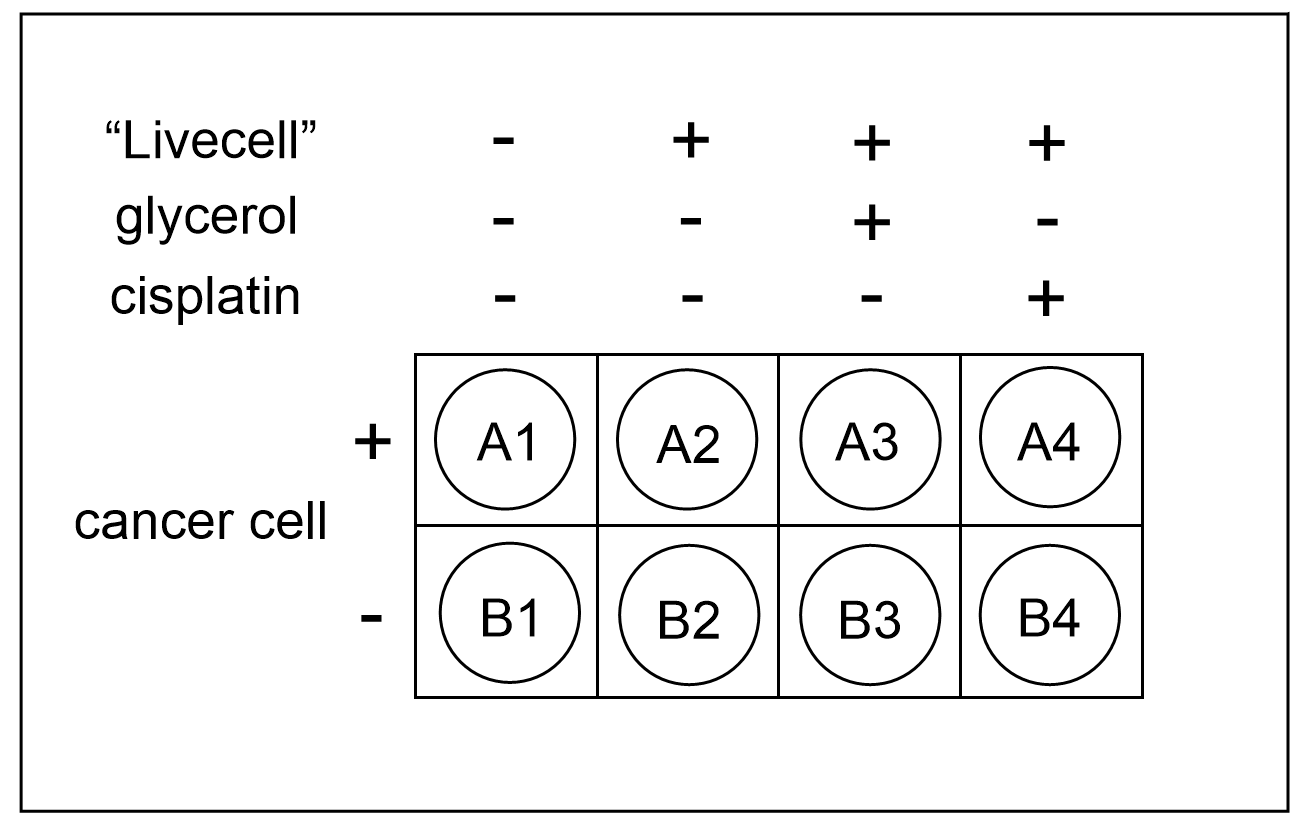5.3 – Solutions for Chapter 4 – Chemical Biology
Chapter 4.2 – High-Throughput Screening
1. Potential anti-cancer compounds to kill cancer cells are being tested using a high-throughput assay in a 96 well plate. Live cancer cells are detected using “Livecell”, a dye which is initially blue, but turns colourless in the presence of live cells. The control wells are shown below. Cisplatin kills cancer cells; glycerol does not affect them. Which of the control wells will appear blue at the end of the assay?

A. A4, B1, B2, B3, B4
B. A2, A4, B2, B3, B4
C. A4, B2, B3, B4
D. A1, A3, B1, B2, B3, B4
The correct answer is Option C. Going through each well, the resulting colour of the well can be determined through a step-by-step process. This will involve understanding what’s in the well, then applying that to what conditions need to be met for the blue colour to occur.
Well A1 has no Livecell dye, glycerol or cisplatin, and does have cancer cells. This is indicated on the negatives for the three conditions above, and a positive on the left for cancer cell. The question tells us that the blue colour occurs when the Livecell dye is NOT in the presence of living cells. However, since there is no dye added to A1 in the first place, we can conclude that there will be no colour in the well.
Well A2 has Livecell dye, but does not have cisplatin nor glycerol added, and the well also has cancer cells within. The dye, as the question states, will only change to colourless if there are live cells in the well. Because the cancer cells in the well have no other compounds present to kill them, they remain living and thus the dye will turn colourless.
Well A3 has Livecell dye and glycerol along with cancer cells, but no cisplatin present. The glycerol, as the question states, will not affect the cancer cells in any way, so they will continue living in the well. Because of this, the dye will be exposed to live cells, making it colourless.
Well A4 has Livecell dye and cisplatin, along with cancer cells present, with no glycerol. The question states that cisplatin will kill cancer cells, so we can conclude that the cells should be dead in the well.
The Livecell dye only turns colourless in the presence of live cells, and otherwise it remains blue. Because of the lack of live cells, therefore, the well will appear blue.
Well B1 has no Livecell dye, glycerol, cisplatin or cancer cells. Because of the lack of dye added to the well, the well cannot have any blue colour. Therefore, it remains colourless.
Well B2 has Livecell dye, but no glycerol, cisplatin or cancer cells. Livecell dye only turns colourless in the presence of live cells, and it otherwise will be blue. Because there are no cells in the well, it should appear blue.
Well B3 has Livecell dye and glycerol, but no cisplatin or cancer cells. The Livecell dye will only turn from blue to colourless if it’s in the presence of live cells. There are no living cells in the well, therefore the dye will remain blue.
Well B4 has Livecell dye, glycerol and cisplatin, but has no cancer cells. The Livecell dye will only turn from blue to colourless if it’s in the presence of live cells. There are no living cells in the well, therefore the dye will remain blue.
Out of the wells listed above, only A4, B2, B3 and B4 will appear blue, thus option C is correct.
2. A high-throughput screen is performed to test compounds for anti-cancer activity. A compound is considered a hit only if it kills the cancer cells, but not normal cells. One test compound kills both the cancer and normal cells, and this is correctly detected by the assay. What kind of result is this?
A. A false control result.
B. A true negative result.
C. A false positive result.
D. A false negative result.
The correct answer is Option B, a true negative result. The first thing is identifying what result we wanted to see which would be denoted as a positive result: after adding the compound, cancer cells die but normal cells are preserved/alive. Anything other than that positive result would be a negative result, which there are 3 outcomes. The negative results could be that no cells are affected (including both cancer and normal cells) which means there is no activity, or all cells die/are affected (including both cancer and normal cells), and lastly, cancer cells survive but normal cells die which is the reverse of what we are looking for. Knowing this, we can strike out option A and option C as control results are not a thing (controls are used for experimental reliability, not to classify results), and we did not see a positive result in this scenario.
Now that we only have 2 options left, we need to identify whether the negative result was a true or false result. True and false are used to define whether the compound that is being tested is responsible for the result (true) or if the result occurred due to any external factors other than the compound itself (it did not interact at all) which in this case making it appear negative when it is actually positive (false). Because the observed death of cells occurred after the addition of the compound, we can confirm the compound was responsible for the negative result, making this result Option B: a true negative result.

